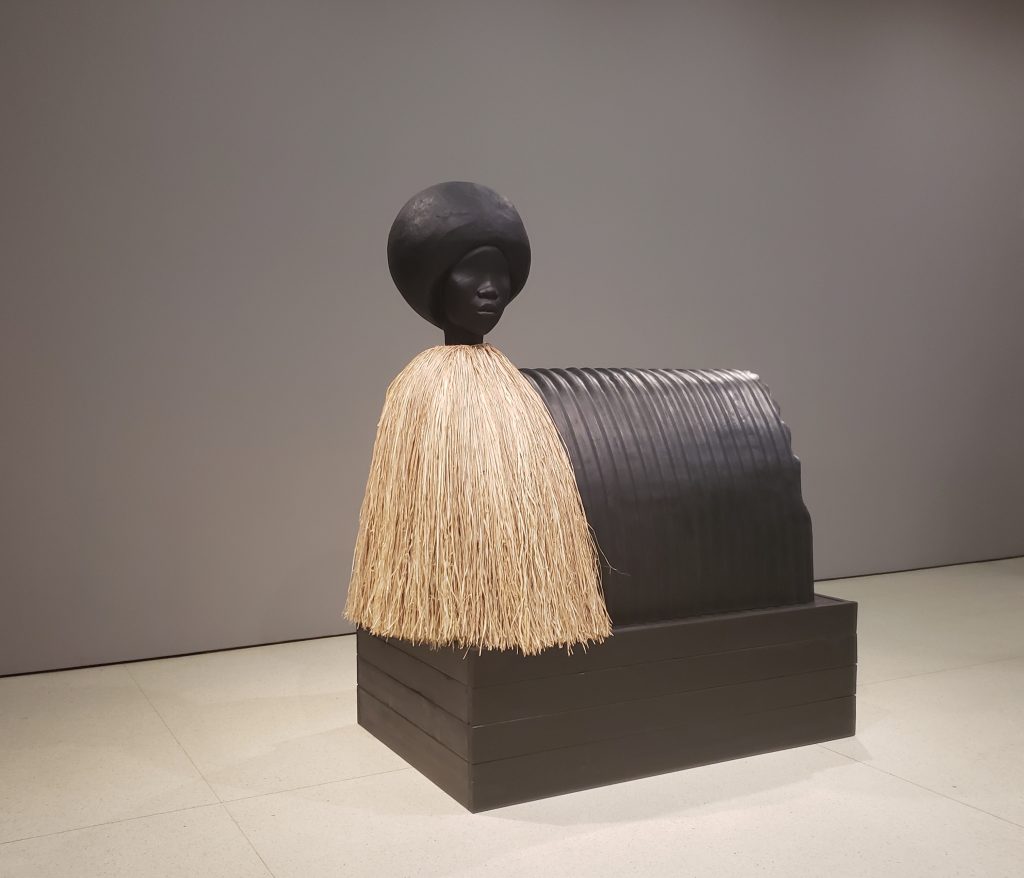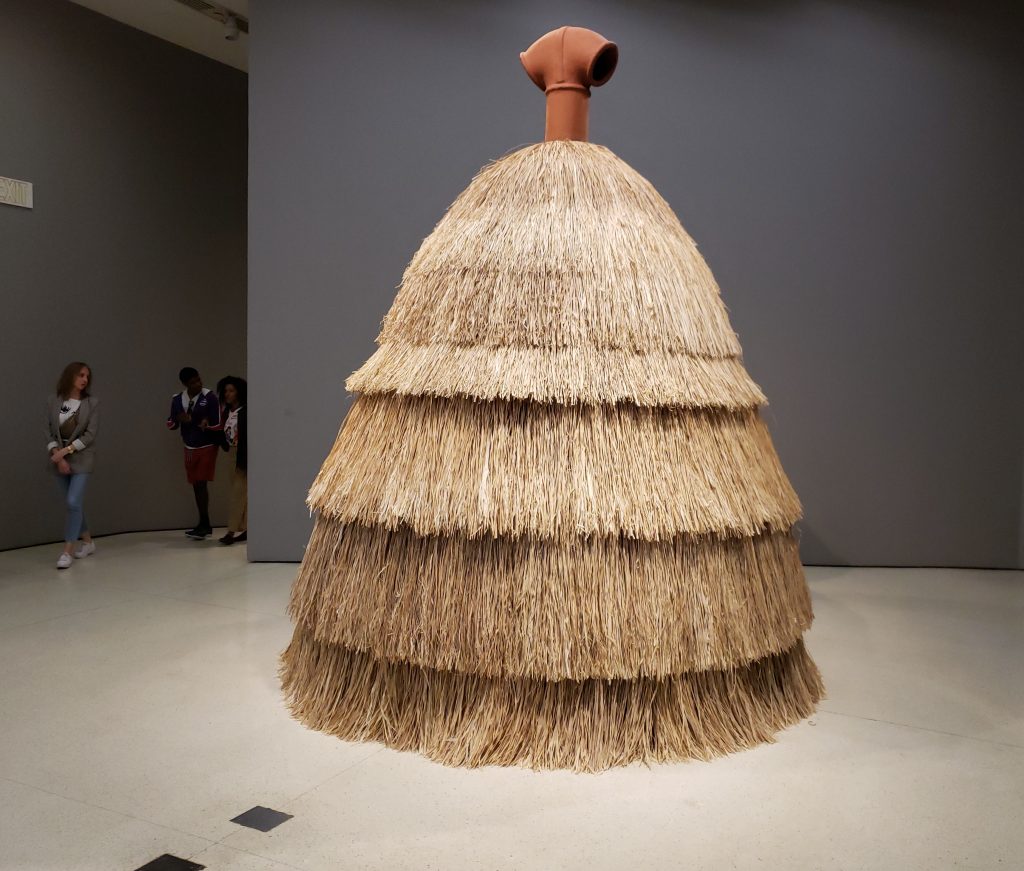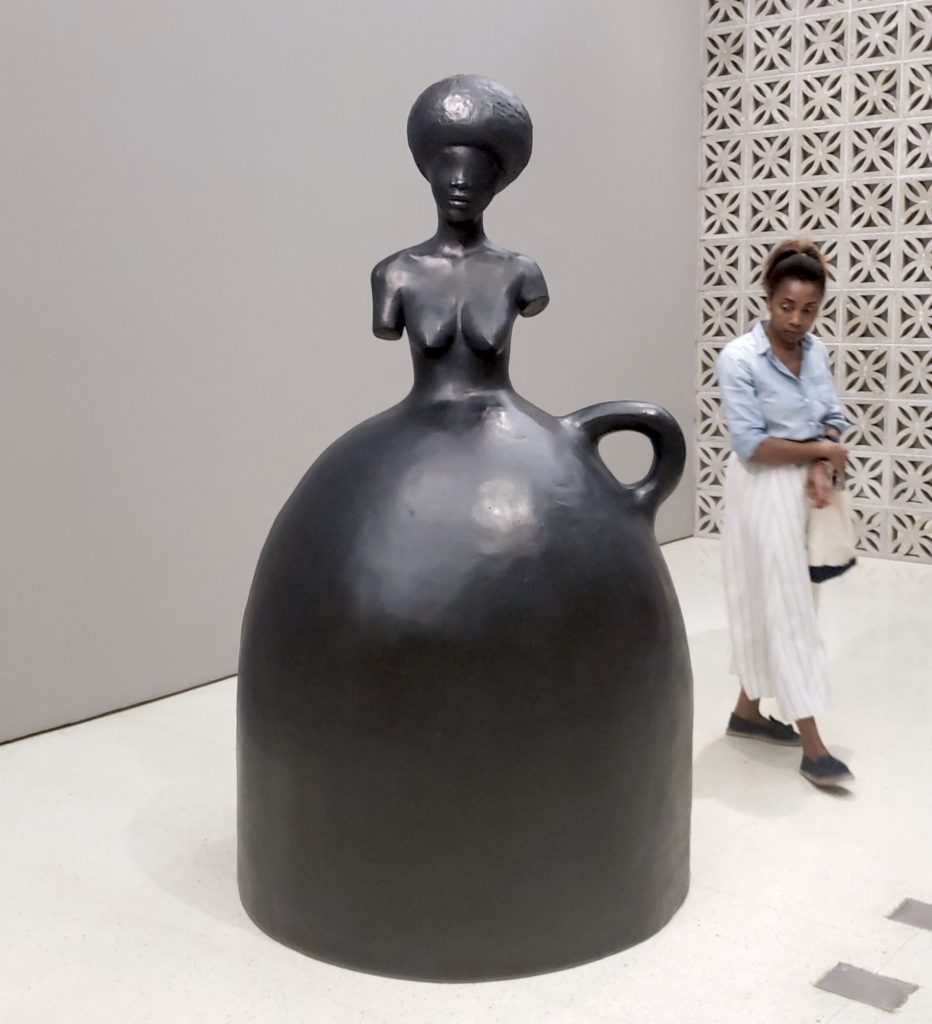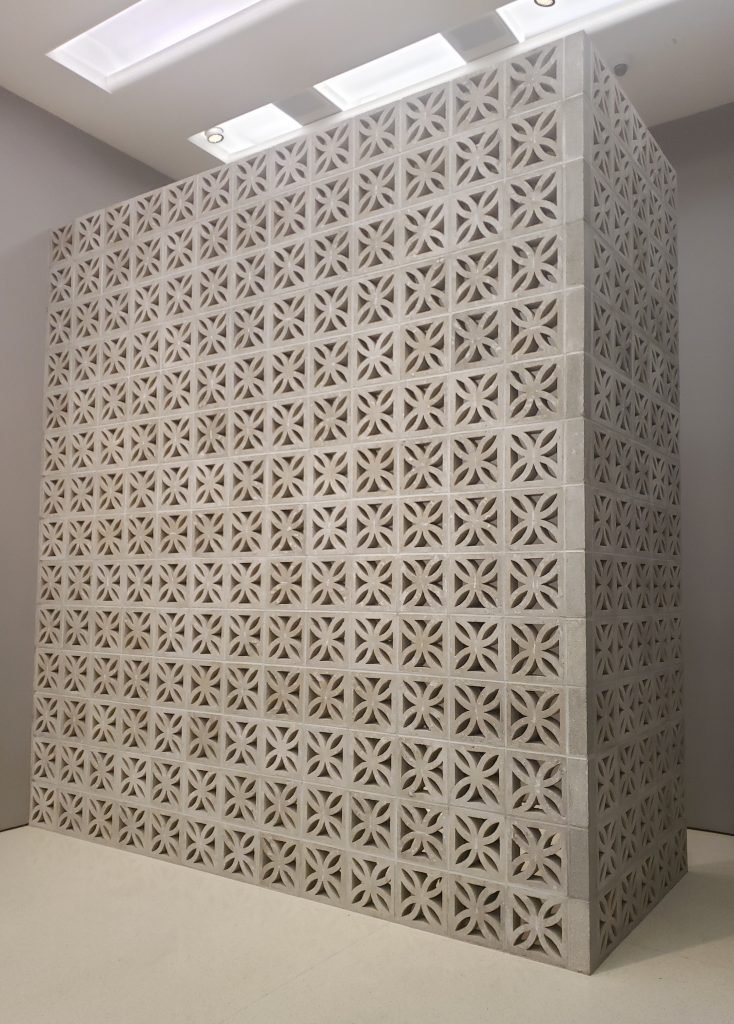Framing new possibilities and autonomy for the Black female body, Simone Leigh excavates the narrative of Harriet Jacobs’ years of hiding from slavery and abuse.

This has been a year of firsts and possibility for Simone Leigh, American artist from Chicago born to Jamaican parents. She is the first artist to be commissioned for the High Line Plinth in New York City where she erected a 16-foot bronze sculpture entitled Brick House. She is one of seventy-five artists exhibiting work at the 2019 Whitney Biennial and the winner of the 2018 Hugo Boss Prize, distinguished amongst artistic awards for having no limitations on the nominees’ background, age, or artistic medium. To establish the prize, Leigh presents a battalion of sculptures and experimental soundscapes at the Guggenheim Museum entitled “Loophole of Retreat”. The artist, Black feminist scholar Tina Campt, and cultural historian Saidiya Hartman curated the exhibition’s accompanying conference of the same name, inviting international artists and scholars to the Guggenheim Museum in May. Over the course of her career, Leigh has also shown her work at the Hammer Museum in L.A., the Tate Exchange at the Tate Modern in London, The Studio Museum in Harlem and at other prestigious art institutions.
Famously known for her contention that Black women are her primary audience, Leigh has cultivated an artistic practice that ranges from sculpture, video, and installation, and is deeply engaged with Black feminist theory, literature, and histories. Her distinct aesthetic and visual language are influenced by her training as a ceramicist, as well as her study of ancient African art forms, adobe structures and American vernacular architectures and art forms. Thus, Leigh’s work is motivated by her studies of Black social life, past and present.
“Loophole of Retreat” deftly embodies the artist’s distinct gifts, transmuting space and time with Black diasporic art forms, slave narrative, carceral histories and archival texts. Similar to her previous works, No Face (Pannier) (2018) and Trophallaxis (2017), Leigh gestures to and produces other futures while also attending to form, evident in her use of material, historical mediums, sculpture, and performance art. Almost overburdened by the materials engulfing the face, hanging around its waste, and the artist’s hands on its upper body, No Face (Pannier) embodies its historical specificity in name and form. The piece is not a pannier in the literal sense: a basket, carried by one whose job it is to burden, or the portion of a skirt meant to uphold the skirt around the hips. Instead, it is a gesture, embodying and transgressing the historical specificity of the black female body. The comparatively sterile, bug-like Trophallaxis reaches elsewhere through the use of materials that would seem futuristic. Nebular, bulbous, and jugular, Trophallaxis alludes to the body but also initiates a different exchange between the art object and the viewer’s body and sensorium. “Loophole of Retreat” riffs on these pieces, pushing them further. This new suite of sculptures similarly personifies agencies, but they perform in ways not yet seen or felt.
As you walk through the exhibition you cannot but ask: What narratives are the artist staging? And how are they coming to be? The truth is that Leigh’s exhibition employs nontraditional narrative forms and supple materials, layering multitudes of possibilities and ulterior futures. It all depends on where and how you look.
The narratives in “Loophole of Retreat” coalesce, intertwine and swirl around the gallery collapsing time and alluding to the possibilities the show unearths. For instance, the presence of Harriet Jacobs’ 1861 slave narrative, Incidents in the Life of a Slave Girl,1 both frames the show and is the exhibition’s namesake. “Had the least suspicion rested on my grandmother’s house, it would have been burned to the ground. But it was the last place they thought of. Yet there was no place, where slavery existed, that could have afforded me so good a place of concealment.” The other narratives emerge in the exhibition’s last two pieces entitled, Loophole for Retreat and The Village Series #14. The sound montage that radiates on a low frequency throughout the gallery space compiles sound sequences from several historic and mundane moments in Black social life: “a recent protest at a Brooklyn prison and news coverage of the 1985 fatal police bombing of the residence of MOVE, a Philadelphia-based black revolutionary organization,” as well as a sonic homage to a member of MOVE who was eight-months pregnant in 1978 when she was incarcerated.2 According to the curatorial text, Leigh calls the experimental soundscape, created in collaboration with artist Moor Mother, a “sonic protection.”
Written and dispersed to whites and free blacks alike and meant to prove the atrocity that slavery was, slave narratives are a specific genre of literature. Perhaps the most comprehensive narrative by an ex-enslaved woman, Jacobs’ tale is true to the genre. It is indeed a tale of the brutality, fear, and precarity of enslavement, however, her narrator Linda Brent’s story charts the difficulties and punishments of the enslaved black woman to evade sexual exploitation. After being sold to Dr. Flint, a cruel man bent on forcing himself upon her, Brent repeatedly concocts methods for escaping his advances. One way was by entering into an affair with a white neighbor, Mr. Sanders with whom she births two children. When Flint learns of the affair, he does not sell Linda to Sanders as the latter hoped. Instead, he decides to send her to a plantation to work as a field hand. Discovering that her children may suffer the same fate, Linda decides to hide in the garret of her grandmother’s home. There, we find ourselves in Linda’s “Loophole of Retreat.”
Towering, circular, and visually appealing, Panoptica escapes recognition. Initially ungraspable, the sculpture elicits a reaction of awe and curiosity. Is it a dress? Or is it a house?

Prior to her stay in the garret, the only other occupants are rats and mice. Nine-feet long and seven-feet wide, she could not stand, but she could sleep comfortably as long as she did not roll over and down the slope of the enclosure. There were no openings for light or air, but her uncle had created a trap-door that led to the storeroom through which she communicated with them. Although the garret was imprecise in that it did not hold all of what Linda desired, it did have basic tools from which she could fashion her own possibility. There was safety, shelter, and even a gimlet she used to cut into the floor to see and hear her children play. Confined within the garret for months, Linda conveyed her deepest desires, reiterated by Hartman at the “Loophole of Retreat” conference: “I longed to draw in a plentiful draught of fresh air, to stretch my cramped limbs, to have room to stand erect, to feel the earth under my feet again.” She spent several years in the garret before escaping North. Her freedom was not yet procured. She would go for years, debilitated from her time in the garret, evading the law, forging tactics of survival and attempting to secure freedom for herself and her children—by any means necessary.
This dense historical narrative, crafted into ambiguous art objects, hits the viewer as they walk across the threshold of the art gallery. There, we are met by three sculptures. To the left, immediate, and the largest sculpture in the space is Panoptica. Directly in front is Sentinel, a wide sculpture, whose face we cannot see until we approach it. Further into the space is Jug, black, mystifying, and compelling. Unassuming, and quite easily confused as just a wall is the industrial, yet ornate Loophole of Retreat. To the unsuspecting visitors, The Village Series #14, which evokes tenderness, intimacy, and pain, is perched behind the concrete wall, waiting. We are in the domain of these objects.
Panoptica (panóptica is the feminine form of panóptico, originating from the Greek words panóptēs which translates to all-seeing) though not accented by the artist, suggests several historical periods, locales, and modes of surveillance.3 And that is the point. Towering, circular, and visually appealing, Panoptica escapes recognition. Initially ungraspable, the sculpture elicits a reaction of awe and curiosity. Is it a dress? Or is it a house? Completely parabolic, this sculpture remains in a state of ambiguity, neither object nor subject, but both, suggesting the female body. Made of terracotta pipe and chimney as well as raffia sculpture, Panoptica droops down from its topmost limbs alluding to human shoulders. Architecturally, Panoptica incites the feelings of being watched while simultaneously evading our gaze. Without face and eyes yet peeking down at the gallery, it disallows the viewer’s recognition. However, the objects circularity engages the body. Not only did I walk around it—though I was dwarfed by its large size—but, I left wondering about its structure and interiority. Similar to Constantin Brâncusi, Leigh’s use of material complicates the question of the base. Ambiguous, the structure is several objects at once. A sign of multiple possibilities: a new technology, an object of surveillance, and a prototype for freeing the Black female body. Refusing the gaze, gazing back—all seeing.
As the hum and prattle of the gallery continue, opaque sounds continue to reach the ear. The material is alluring, but where is the source? The art objects overwhelm the senses, discombobulating. Sentinel, stands watch, situated adjacent to her sister, Panoptica, facing the inside of the gallery, allowing passersby. Her afro’s texture, the externalized labor of the artist. Raffia hanging from her neck conjuring images of Africa. Like Panoptica, Sentinel defies notions that the base is not an art object or part of the art piece itself. What Leigh does that Brancusi could not, is weave form with narrative. The black, bronze sculpture’s “base” allude to Linda’s garret, where she was kept “safe” in the small shed of her grandmother’s house on which “some boards were laid across the joists at the top, and between these boards and the roof.”4 Sentinel stands guard as I cross another threshold. Who has intruded? Besides those who have placed their pale hands on the art piece’s textured head, throwing the object’s blackness into sharp relief.
Avatars, according to Uri McMillan, author of Embodied Avatars: Genealogies of Black Feminist Art and Performance, “act as extensions of our agency, while also revealing a persistent slippage between real and virtual worlds,” a phenomenon she calls “x-reality.”5 What is the possibility of the avatar?6 After all, both Panoptica and Sentinel occupy several worlds in space and time, transporting the viewer, moving the body and guarding the present. Though objectified and taken in by a pale hand, Sentinel guards.
Simultaneously sacred and private, Jug advances the formal and aesthetic strivings of the first two objects. In both name and form, Jug molds and is molded by the body, mutating the body into material. Leigh’s hands linger on the Afro, lovingly fingered and caressed.


Simultaneously sacred and private, Jug advances the formal and aesthetic strivings of the first two objects. In both name and form, Jug molds and is molded by the body, mutating the body into material. Leigh’s hands linger on the Afro, lovingly fingered and caressed. We have crossed the threshold of another world, transitioned far past Panoptica. Jug is body and object personified. All black and bronze, the object has no beginning or end. The “base,” (or is it the jug?), stands erect, unnippled. Shouldered, un-limbed. Like Sentinel, unseeing, lipped, and broad-nosed—protected from the degradation of sight, seeking refuge. Perhaps, it is in the feeling instead. A prison kept captive, alluding to depth in both name, color, and metaphor. What are the contents of this jug? Illegible, eternal, unimaginable.
Approaching “Loophole of Retreat”, the sound comes closer, but it is still faint. Clank. Clank. Clank. Humming. Is it a Song? Is this encasement, with its richly carved loopholes, everything Linda desired? Other visitors come in and touch The Village Series #14. The bronze stoneware sculpture sits in the center of the small space, tinged silver where the skin and (or) braids of the material meet. The piece evokes the intimacy of touch as well as pain. Is someone singing? Listening closely, you would hear someone singing “I’m every woman, it’s all in me” then: Clank. Clank. Clank. Is it the sound of Double-dutch ropes hitting pavement? Or hand clapping games? Explosions. Uprising. More songs. This is on a loop. When a baby cries, the mother sings “Hush Little Baby”: “…if that mockingbird don’t sing.” A mother says to the child: “I love you.” It was pure pleasure, desire, and longing to be in this place. Possibly everything Linda longed for: to inhale a draught of air and feel the sun on her skin.
Although the “Loophole of Retreat” exists in a white gallery space at the Guggenheim Museum, Leigh provides several means for escape, in sonic materials and otherwise. Out of time, out of space, out of our world, we enter where her objects allow. Merging the public and private, the artist gives depth and layers that are as indiscernible as her artwork’s interiority. They captivate and penetrate. We are in the art world, materially and affectively displaced, but sensorially engaged. Leigh shows us that black life manifests itself in multiple folds, at once transient and infinite.
Loophole of Retreat is on view until October 26, 2019.
_
Imani Noelle Ford is a visual artist, writer, and scholar from Chicago and is based in New York. They will commence Columbia University’s English & Comparative Literature PhD program this fall.
1 Harriet Jacobs, Incidents in the Life of a Slave Girl (Unabridged) (Mineola, NY: Dover Thrift Editions, 2001).
2 Wall text, Loophole of Retreat, The Village Series #14, Solomon R. Guggenheim Museum, New York.
3 Here, I allude to Jeremy Bentham’s design of the Panopticon which he published in 1785. It is well known as the symbol of control, domination, and surveillance in the modern western world. French intellectual and critic, Michel Foucault took up Bentham’s Panopticon in 1970, expanding the idea and contending that the Panopticon is a symbol of social control that acts in the everyday lives of modern citizens. They are both agents and victims of this system of surveillance.
4 Jacobs, 95.
5 Uri McMillan, Embodied Avatars: Genealogies of Black Feminist Art and Performance (New York, NY: New York Univ. Press, 2015), 11.
6 McMillan also uses Leigh’s work entitled Breakdown as one piece of performance art that embodies his argument that black women’s performance art has continuously utilized the black female body as avatar to do what he terms “performing objecthood.” This elastic objecthood, he contends, allows “black subjects to become art objects.” McMillan, 7.




